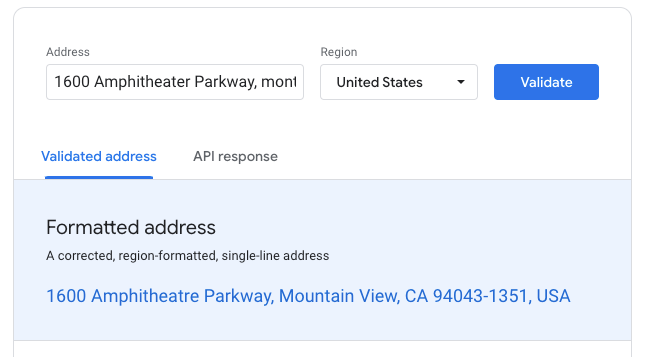מבוא
Address Validation API הוא שירות שמקבל כתובת. הוא מזהה רכיבי כתובת ומאמת אותם. הוא גם מתקנן את הכתובת למשלוח דואר ומוצא את הקואורדינטות הכי מדויקות שלה. לחלופין, לכתובות בארצות הברית ובפוארטו ריקו, אפשר להפעיל את מערכת התמיכה בדיוק הקידוד (CASS™).למה כדאי להשתמש ב-Address Validation API
בעזרת Address Validation API, תוכלו לשפר את יכולת החיזוי של המשלוחים ולצמצם את מספר המשלוחים שלא מגיעים ליעד, וכך לשפר את חוויית הלקוח. כדי לעשות את זה, צריך לזהות כתובות לא תקינות ולקבל מידע טוב יותר על מאפייני הכתובות.
יכול להיות ש-Geocoding API יתאים יותר לצרכים שלכם אם אתם לא צריכים לאמת את רכיבי הכתובת הספציפיים. Geocoding API ממיר כתובות לקואורדינטות של קווי רוחב ואורך. Address Validation API מאמת כתובות כדי לוודא שהן נכונות. השוואה מפורטת זמינה במאמר יצירת יכולת אימות מיקום באמצעות הפלטפורמה של מפות Google במרכז הארכיטקטורה.
מה אפשר לעשות באמצעות Address Validation API
באמצעות Address Validation API (ה-API לאימות כתובות), אפשר לקבוע אם כתובת מסוימת מתייחסת למקום אמיתי. אם הכתובת לא מתייחסת למקום אמיתי, ה-API יכול לזהות רכיבים שגויים שאפשר להציג ללקוחות כדי לתקן אותם. הנה דוגמה לתהליך עבודה באמצעות ה-API:
הלקוח מזין כתובת – בתמונה הבאה מוצג טופס בסיסי שמאפשר ללקוח להזין כתובת, אולי כחלק מתהליך התשלום.
האפליקציה שולחת את הכתובת אל ה-API – האפליקציה מעבירה את הכתובת הזו כקלט ל-Address Validation API.
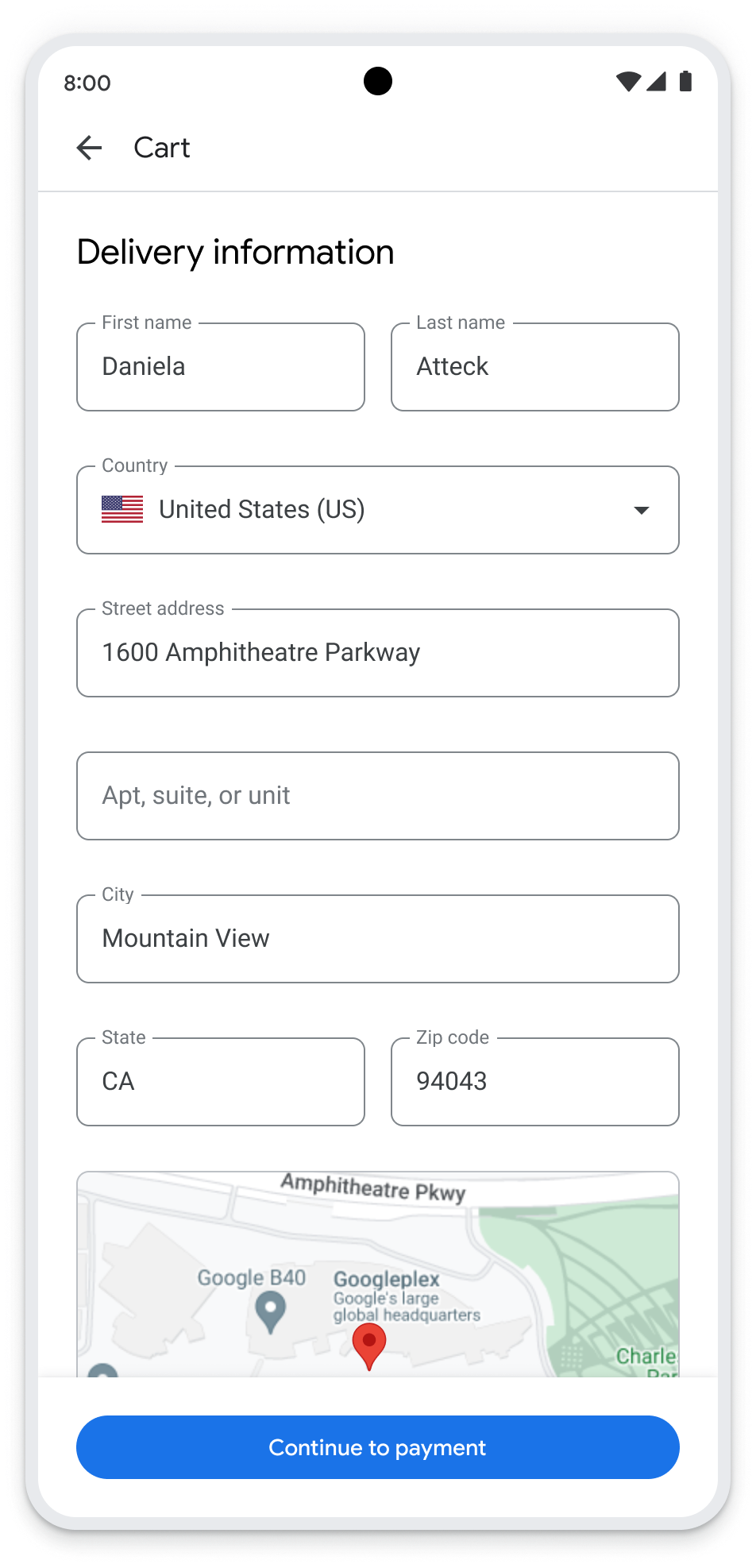
ה-API מאמת את הכתובת ומבצע סטנדרטיזציה שלה – בתגובה שלו, Address Validation API מחזיר את הכתובת המלאה כפי שנקבעה על ידי ה-API, או מציין איפה חסר מידע.
הלקוח מאשר או מתקן את הכתובת – בהתאם למה שמוחזר מה-API, אפשר להציג ללקוח את ההנחיות הבאות: א. מאשרים את הכתובת המומלצת. ב. מספקים את המידע החסר. ג. מתקנים את הכתובת.
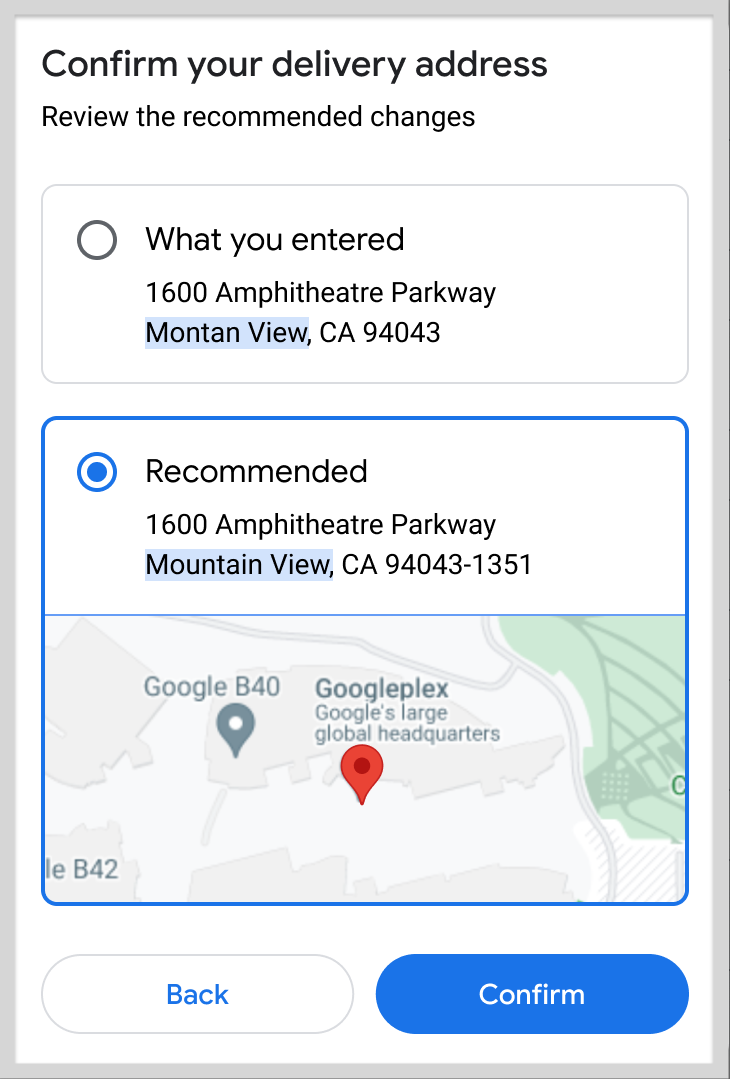
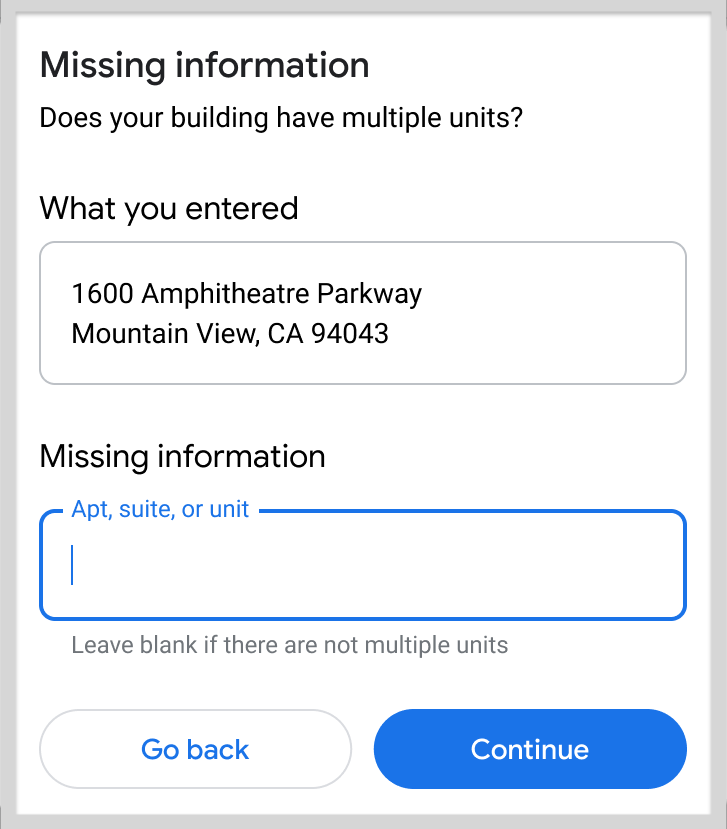
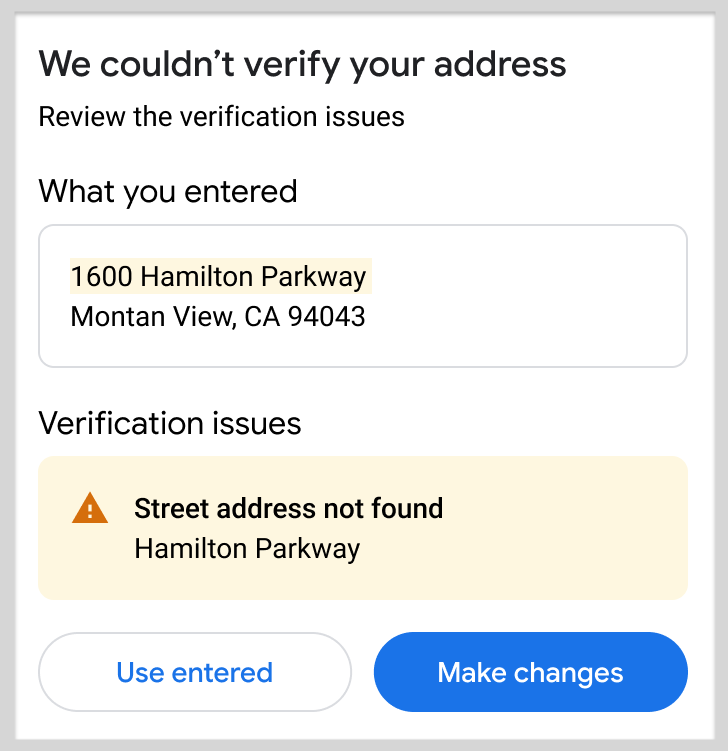
איך פועל Address Validation API
אימות הכתובת מקבל בקשת POST עם הכתובת בפורמט של גוף JSON. היא מפרידה את הכתובת לרכיבים נפרדים, ואז מנסה את הפעולות הבאות:
- תיקונים – מספק בדיקות אימות ברמת הרכיב, כולל מיקומי משנה אם הם זמינים.
- השלמה – ניסיון להסיק רכיבי כתובת חסרים או שגויים.
- פורמטים – מנקה ומבצע סטנדרטיזציה של הפורמט של רכיבי כתובת.
משאבים
בטבלה הבאה מופיע סיכום של המשאבים שזמינים דרך Address Validation API, לצד הנתונים שמוחזרים. פרטים ספציפיים מופיעים במאמר הפניית API לאימות כתובות.
| מקורות נתונים | נתונים שהוחזרו |
|---|---|
|
רכיבי כתובת בפורמט JSON. |
כתובת מלאה ומאומתת (אם אפשר). סטטוס האימות של כל רכיב בכתובת. המקומות שבהם אפשר להשתמש בכתובת:
מומלץ לעיין בקטע הסבר על תגובת האימות. |
איך משתמשים ב-Address Validation API
| 1 | לניסיון ההדגמה | כאן אפשר לנסות את ההדגמה עם מגוון טפסים של כתובות, חלקם נכונים וחלקם שגויים. ההדגמה מאפשרת לבדוק את הערכים שמוחזרים מהשירות ואת תגובת ה-API בפורמט JSON. |
| 2 | בדיקת הכיסוי | כדי לראות באילו מדינות ואזורים יש תמיכה ב-Address Validation API, אפשר לעיין בפרטי הכיסוי. |
| 3 | הגדרה | מתחילים עם הגדרת פרויקט ב-Google Cloud ופועלים לפי ההוראות שבהמשך. |
| 4 | בקשה לאימות כתובת | מתחילים עם כתובת בסיסית, ואז, כדי להגביר את הדיוק, אפשר להפעיל CASS (רק לכתובות בארה"ב ובפורטו ריקו). איך מבקשים אימות כתובת |
| 5 | עיבוד תגובה | תגובת Address Validation API מספקת שני מאפיינים, שכל אחד מהם משמש למטרה אחרת. הסבר על תשובה בסיסית |
| 6 | שיפור הדיוק של האימות | כדי לעזור לנו לשפר את הדיוק של הכתובות, אתם יכולים לשלוח משוב על התשובות של Address Validation API. איך מעדכנים כתובות |
ספריות לקוח זמינות
רשימה של ספריות הלקוח שזמינות ל-Address Validation API מופיעה במאמר ספריות לקוח.
מידע על CASS™
שירות הדואר של ארצות הברית (USPS®)1 מפעיל את מערכת התמיכה בדיוק הקידוד (CASS™) כדי לתמוך בספקי אימות כתובות ולאשר אותם. שירות עם אישור CASS Certified™, כמו Address Validation API, אושר כי הוא מסוגל להשלים מידע שחסר בכתובת, לתקנן אותה ולעדכן אותה כדי לספק לכם את הכתובת העדכנית והמדויקת ביותר.
האימות CASS לא מופעל כברירת מחדל והוא נתמך רק באזורים 'US' ו-'PR'. כדי להפעיל CASS, צריך להגדיר את enableUspsCass לערך true כחלק מבקשת אימות. מידע נוסף זמין במאמר אימות כתובת.
במסגרת השימוש שלנו בשירותי USPS, USPS בודקת בקשות לכתובות שנוצרו באופן מלאכותי. אם USPS מזהה כתובת קלט שנוצרה באופן מלאכותי, Google נדרשת להפסיק לאמת כתובות עבור הלקוח ולדווח ל-USPS על פרטי הקשר של הלקוח (שם וכתובת), על כתובת הקלט הרלוונטית ועל נתוני שימוש מצטברים. השימוש ב-API מהווה את הסכמתכם לתנאים הספציפיים לשירות.
המאמרים הבאים
- לצפייה בהדגמה: עוברים אל הדגמה
- בדיקת אזורי הכיסוי: אפשר לעבור אל פרטי הכיסוי של מדינות ואזורים
- שליחת בקשת אימות ראשונה: עוברים אל שליחת בקשת אימות כתובת
- עיבוד כתובות בכמויות גדולות: אפשר לעבור אל שימוש ב-Address Validation API לעיבוד כתובות בכמויות גדולות
-
הפלטפורמה של מפות Google היא בעלת רישיון לא בלעדי של שירות הדואר של ארה"ב (USPS®). הסימנים המסחריים הבאים הם בבעלות שירות הדואר של ארה"ב (USPS®) ונעשה בהם שימוש באישורו: United States Postal Service®, CASS™, CASS Certified™. ↩


